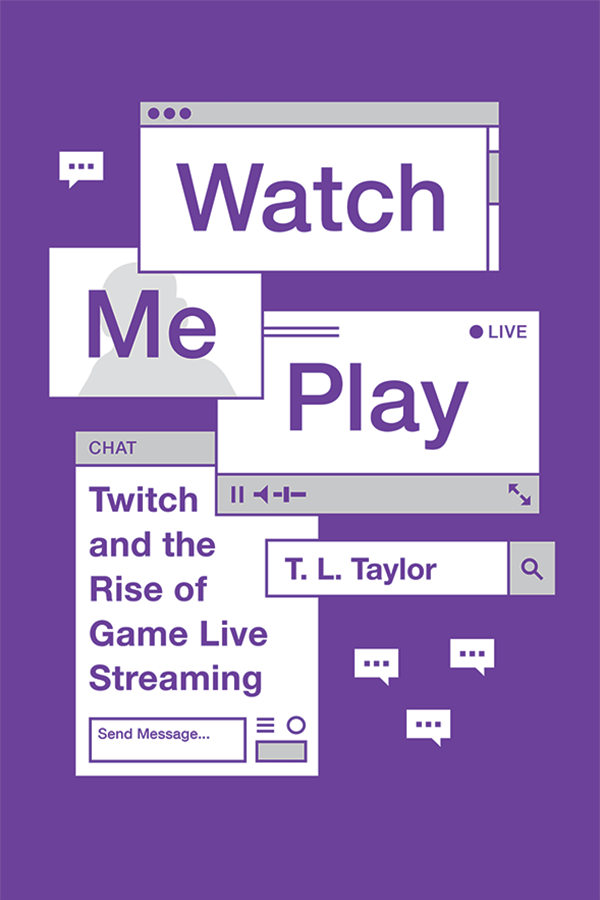Game livestreaming has entered into popular culture in a big way. Twitch, a platform that boasts having millions of broadcasters producing programs for tens of millions of visitors each day, offers up all kinds of live content 24/7 to viewers around the world. The site hosts a range of shows, from “variety” streamers who broadcast different types of games to massive esports tournaments that pull in hundreds of thousands of viewers over the course of a weekend. You can also find live broadcasts of people making cosplay outfits, cooking, or just streaming everyday life. Livestreaming has become not just a part of game culture, but of our everyday media worlds more broadly. And while a tremendous amount of creative production is happening on the site, big issues remain regarding the governance, regulation, and monetization of user-generated content. While playing games for an enthusiastic audience may seem like a dream job, it can be incredibly hard work that requires a tremendous amount of self-training, skill-up, and hustle. Livestreamers are not only changing the face of gaming and giving us a glimpse into the future of media production, their one-person production studios—and businesses—operated out of their homes sync up all too well with broader trends around labor, online platforms, and the future of work.
I wanted to get a sense of how broadcasters transform their private play into public entertainment, and what trying to make a living from this new media form actually looks like. So late one February night, around 2 a.m., I found myself heading down a Florida interstate to visit a popular broadcaster at his home to see him do his livestream in person. We’d previously spoken on Skype, and I had watched a bunch of his broadcasts, but I was interested in getting a peek into what it looked like from the other end of the screen. Despite being a night owl, I was already getting tired and couldn’t quite imagine the prospect of rallying to go live to thousands of viewers at this time of day.
But this was his usual broadcast slot, intentionally chosen to skim off North American audiences from other streamers who were wrapping up their shows and snag Australian viewers just starting their evening. Fortunately, I had the easy job; my plan was to sit off to the side and just watch. As I pulled into the driveway, I admit being surprised and impressed. I hadn’t known quite what to expect, especially given the financial insecurity so many streamers endure. Yet this was a suburban middle-class home you’d see in any number of cities around the country: two stories with a little lawn out front, surrounded by others that looked a lot like it. The street was quiet at this time of night, and the house was dark. As I rang the bell, I worried for a moment that I was either at the wrong place or about to wake people.
But he answered, saying he’d just gotten up from a nap. The house was silent as the rest of his family—wife, baby, and brother who lived with them—still slept. The open-plan living room and attached kitchen were arranged much like you’d expect of a young family—with baby things, TV/DVD setup, and mail, along with assorted stuff cluttering the counter. He offered me coffee, but in a bit of grogginess put a cider pod in the machine by mistake. I didn’t want to be any hassle (always the tricky bit of research as you descend into someone’s work or home) so said no problem while he gave me a quick tour of the downstairs. Perhaps sensing that I was taking it all in, he spoke about how amazed he was that they got to live in this house, how lucky he was to have the viewers he did, and how he never thought that this could be his life. Having previously spoken with him while he and his family were living with relatives, I knew there was immediacy to this feeling, and his gratitude felt genuine.
We made our way upstairs to the room dedicated to his broadcasts, and he quickly fired off a tweet giving his followers a heads-up that he’d be live soon. His setup wasn’t anything fancy, just a generic black desk with a couple monitors, a few chairs, a lamp, assorted boxes, and gear here and there. His computer and monitors were already up and running as he sat down and began a ramp-up process. He started by looking at the Twitch front page, seeing viewer counts, assessing audiences, scanning the games and streamers that were on, and estimating when they were likely to sign off. Even before he began streaming, there were already 700 people on his channel hanging out in chat waiting for him. He decided to do a quick straw poll of the audience for them to pick what he should play. This involved using a third-party website to create a quick survey and pasting it multiple times to the chat. About 20 votes in, he settled on a game and sent out a “going live” message to Twitter. It was now approaching 3:30 a.m., and while the rest of the house was still asleep, he began his broadcast. Although we’d been speaking in fairly quiet tones up until that point, with the start of the show the vibe shifted and I saw him transition into his entertaining persona.
Over the next five or so hours, I watched him play through a few different games and keep an audience of 4,000 entertained. Most strikingly, I saw the high degree of behind-the-scenes work happening. In interviews with streamers I’d heard about all the things they juggle while live, but seeing it in person was impressive. One of his screens showed his game, while the second monitor displayed a large chat window, his broadcasting software (which included a graphical trigger system for automatic messages that would pop up in the broadcast), and a window showing details about who was subscribing, donating, and following. The channel’s chat window was a central part of the production, and he was constantly keeping his eye on the conversation, issuing hellos, thanks, and responses. Viewers reminded him a few times about donations he’d missed acknowledging, and he apologized each time, promising to catch up with the backlog. Amid all the humor and sometimes-raunchy jokes, his heartfelt thanks to his viewers came through. At one point, perhaps because someone spotted me in the background, he waved me into the frame to say hi. I did so quickly and then tried to scoot my chair back to the side. I definitely didn’t have what it takes to stay on camera.
Eventually his brother popped his head into the room to check in about something. The rest of the house was waking up. He started wrapping up the broadcast. I noticed during the session that he hadn’t run any ads and only now at the end showed a few. He took a look at who was currently streaming and picked a few fellow broadcasters to suggest that his viewers switch over to watch, instigating a friendly “raid.” Once he turned off the broadcast, he showed me all the other tools in the background that he uses to monitor his productions. While he didn’t need to directly call on them during the session, he pointed out the Skype window where all his moderators were gathered to coordinate their handling chat. Finally, he tallied up the results of evening’s session: more than 50 new subscribers, more than 800 new followers, and more than $500 in donations.
We headed downstairs to say hello to his family, now all woken up and starting their day. I’d met his wife before so we hugged and chitchatted, but it was the first time I’d seen his new baby. She was happy and reached out for her dad when she spotted him. He took her and bounced her around with morning hellos. The rest of his day would be a mix of helping with child care, errands, and all the prep and postproduction work that streamers are constantly doing. I said my goodbyes, and as I pulled away from the quiet suburb to make my way back to the hotel for some sleep, I couldn’t help but think about how in average homes around the world these quirky one-person studios were appearing and broadcasting out content to millions of viewers every day.

My new book, Watch Me Play: Twitch and the Rise of Game Live Streaming, explores these individual livestreamers who are transforming their private play into public entertainment. In particular, I focus on those aspiring to create a new professional identity in this space. Whether they are “variety” broadcasters who play many different game titles, or esports players sharing hours and hours of practice of a single game, streamers are not only developing conventions for game spectatorship as they broadcast but are also constructing a new form of work. While many variety streamers still hold day jobs, a number of them are pursuing full-time professional livestreaming, often supported by family or partners. Esports competitors increasingly supplement tournament income and broaden their sponsorship opportunities via live streaming. Despite working with differing kinds of games and genre conventions, both types of streamers are typically based in home studios (frequently located in their living room or bedroom) and navigate the labor of producing one’s play for spectatorship. It is usually an economically precarious, if personally fulfilling, path.
Given that Twitch supports synchronous chat running alongside the video, broadcasters are typically engaging with their audiences—saying hello, answering questions, responding to feedback, and over the course of months or years, getting to know them and be known by them. As one longtime streamer put it to me, Twitch allows him to say to his audience, “Welcome to my channel. Now you’re a part of the experience.” This social and emotional labor extends beyond the bounds of the broadcast platform; having a successful channel also often requires attention to other forms of social media. Managing a presence on Facebook, Twitter, and even YouTube, and gaming platforms like Steam can become an important part of building and maintaining an audience. Livestreamers are not only content producers but brand and community managers, too.
Aside from this “front-stage” labor, livestreamers frequently find themselves having to skill up into agile one-person production studios. Whereas traditional media production involves a division of labor spanning a number of skilled technical and creative professionals—from camera operators and audio experts to writers and producers—livestreamers regularly take on all these roles themselves, especially when they start out. While broadcasting, they are not only producing all the creative content but also tend to be simultaneously managing all the technical components to make the production happen. Livestreaming, particularly when undertaken with professional aspirations, becomes the work of play.
Adapted from Watch Me Play: Twitch and the Rise of Game Live Streaming by T. L. Taylor. Copyright © 2018 by Princeton University Press. Reprinted by permission.
